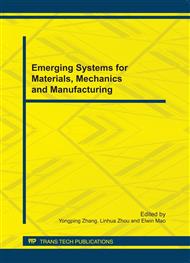[1]
JIANG Ye-hua, LI Zu-lai, YE Xiao-mei, et al. Effect of Matrices on Dissolution of Tungsten Carbide Particulates (WC) in WC Reinforced Iron Base Composite[J]. Foundry Technology, 2007, 56(5): 491-494.
Google Scholar
[2]
S. W. Huang, M. Samandi, M. Brandt. Abrasive wear performance and microstructure of laser clad WC/Ni layers[J]. Wear, 2004, 256: 1095-1105.
DOI: 10.1016/s0043-1648(03)00526-x
Google Scholar
[3]
Zulai Li, Yehua Jiang, Rong Zhou. Dry three-body abrasive wear behavior of WC reinforced iron matrix surface composites produced by V-EPC infiltration casting process [J]. Wear, 2007, 262: 649-654.
DOI: 10.1016/j.wear.2006.07.009
Google Scholar
[4]
WANG Zhi-hui, YANG Ai-di, ZHANG Tian, et al. Dissolution Behavior of WC in WC Reinforced Composite Coatings[J]. Journal of Materials Engineering, 2008, 9: 56-63.
Google Scholar
[5]
YOU Xian-qing, MA Jian-guo, SONG Xue-feng, et al. Dissolution behavior of WC particle in WC steel matrix composites by electroslag melting and casting method[J]. The Chinese Journal of Nonferrous Metals. 2005, 19(5): 1363-1368.
Google Scholar
[6]
Liu De-jian, Li Li-qun, Li Fu-quan, et al. WCp/Fe metal matrix composites produced by laser melt injection[J]. Surface & Coatings Technology, 2008, 202: 1771–1777.
DOI: 10.1016/j.surfcoat.2007.07.053
Google Scholar
[7]
K. Kambakas, P. Tsakiropoulos. Solidification of high-Cr white cast iron–WC particle reinforced composites [J]. Materials Science and Engineering: A 2005, 413–414: 538–544.
DOI: 10.1016/j.msea.2005.08.215
Google Scholar
[8]
Libin Niu, Marabous Hojamberdiev, Yunhua Xu. Preparation of in situ-formed WC/Fe composite on gray cast iron substrate by a centrifugal casting process [J]. Journal of Materials Processing Technology, 2010, 210: 1986–(1990).
DOI: 10.1016/j.jmatprotec.2010.07.013
Google Scholar
[9]
P. Hoffmann, H. Galindo*, G. Zambrano, et al. FTIR studies of tungsten carbide in bulk material and thin film samples [J]. Materials Characterization, 2003, 50: 255-259.
DOI: 10.1016/s1044-5803(03)00100-1
Google Scholar
[10]
H. Romanusa, V. Cimallaa, J.A. Schaefera, et al. Preparation of single phase tungsten carbide by annealing of sputtered tungsten-carbon layers [J]. Thin Solid Films, 2000, 359: 146-149.
DOI: 10.1016/s0040-6090(99)00732-4
Google Scholar
[11]
T·B·Rope Knoff amount. Refractory compounds manual [M]. Beijing: China Industry press, (1965).
Google Scholar


